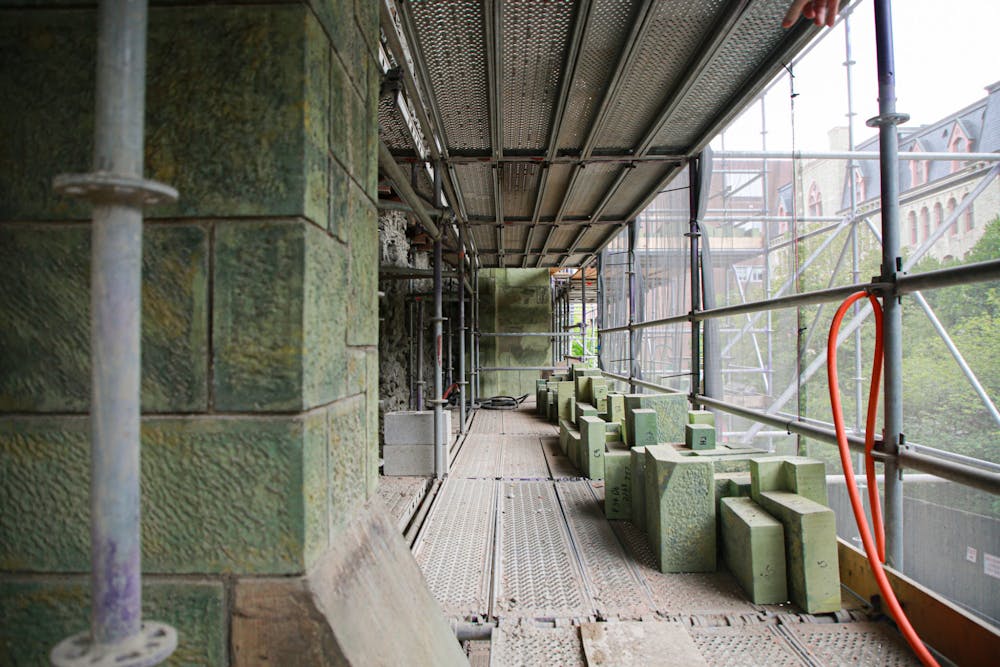When College Hall was first constructed in the early 1870s, stonemasons laid pieces of hand-cut green serpentine stones and built the emerald architecture as it is known today. Now, new technologies scan the western facades of the edifice, recreating unique stones and reimagining the work of those masonries a century and a half ago.
In January 2023, Penn began an $87.4 million project to renovate the campus’s oldest building. With two new elevators, many campus walkways, and hundreds of students rerouted, a project 30 years in the making began. The Daily Pennsylvanian took a tour of the construction site and looked at how Penn is renovating College Hall — brick by brick.

An urban legend has it that at the time of College Hall’s construction, a member of the Board of Trustees was looking to get rid of these strange-looking green stones on his farm, so he offered them to Penn for free. The University welcomed the opportunity, and the distinct green color today was born.
“I can't imagine it's like, ‘I've got a bunch of crappy stones and here, give it to the university,’” William Whitaker, curator and collection manager of Penn’s Architectural Archives said. “I think it was a choice made by the architect.”
The green serpentine cast stones are a main focus of the restoration project.
“It literally crumbles,” Jennifer Kinkead, a director in Facilities and Real Estate Services' Design & Construction, told the DP. “We are doing this restoration so that the building can live for another 100 years, and the [Philadelphia] Historical Commission is very supportive of this project.”
College Hall was added to the Philadelphia Register of Historic Places in 1957, according to a spokesperson for the Philadelphia Historical Commission.
“They're at the point where they have to invest in really making a robust [surficial] finish for another 150 years,” Whitaker added. Penn previously renovated the east wing of College Hall in the 1990s, making the current renovation part of a 30-year-long project.
Dan O'Rourke, senior project manager for FRES Design & Construction, told the DP that one of the masons that originally worked on the building in the 1990s is running the project for the engineering company today.
337 windows will be replaced and 41 will be restored. Though weather is not the only element adding to the deterioration of the wooden window frames — squirrels actively chew on them as well.

The facade is not getting a makeover in its entirety. Many limestone arches over the windows are being preserved because of their structural integrity and historical value.

In addition, all Ivy Stones on the western facade of College Hall have been boxed up by wooden boards to protect them throughout the restoration process.
The interior of the building has been stripped out for renovation as well. For the first time since its construction, Kinkead said that the west wing of College Hall will have central air conditioning.
In addition to modernized electrical systems, the restoration will also feature some new interior designs aiming to highlight historical components of the building — such as beams, arches, and other details.
Two new elevators will be added to the building to increase accessibility and convenience, opening this winter ahead of the conclusion of the restoration. They will have tunnels leading to the east wing as construction continues, and the existing elevator in the central staircase will be dismantled.
“With an older building, there's always things that you find when you open up and uncover the buildings … so that's just a challenge,” O’Rourke said. “But we were ready for it.”
A spokesperson for the Philadelphia Historical Commission told the DP that “all work described was determined to satisfy the Secretary of the Interior’s Standards for the Treatment of Historic Properties,” and — in their view — “Penn has very capable stewardship of its buildings.”

When it opened its doors 151 years ago, College Hall housed the entire University under one roof. Today, it is home to the President’s office, the Provost’s office, the Department of History, classes, and other administrative offices.

“Penn is a place where there's really great examples of architecture from every period since the 1870s,” Whitaker said. “It's important that Penn recognizes the importance of its architectural heritage. That helps us tell the story of this incredible change that's gone on in 150 years being in West Philly.”









